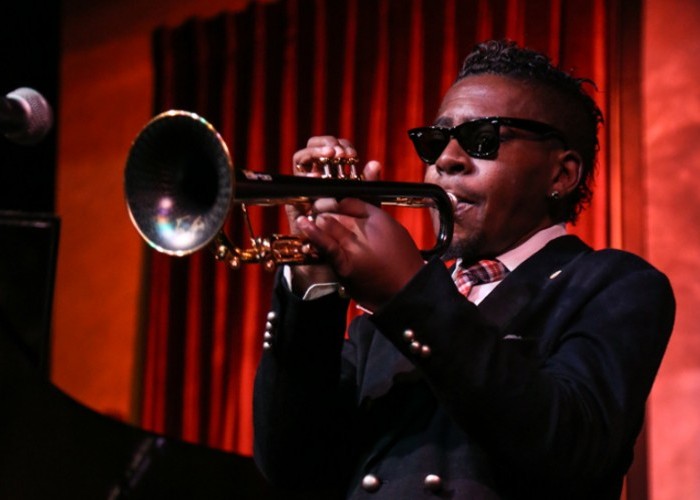Oct 28, 2025 10:47 AM
In Memoriam: Jack DeJohnette, 1942–2025
Jack DeJohnette, a bold and resourceful drummer and NEA Jazz Master who forged a unique vocabulary on the kit over his…

Roy Hargrove (1969–2018)
(Photo: Michael Jackson)As the jazz world continues to mourn the death of Roy Hargrove, the bandleader has been given a posthumous honor, winning the Trumpet category in the DownBeat Readers Poll.
Roy Hargrove died suddenly on Nov. 2, 2018, at the age of 49, from cardiac arrest caused by kidney disease, an affliction with which he had long struggled.
Hargrove was, among many other things, a kind of binding agent in jazz, as trumpeters are wont to be; artistically generous and open-minded, he helped connect all sorts of musicians in a genre that has had its share of aesthetic schisms.
It was entirely uncontroversial—and also extremely cool—to dig Roy Hargrove. He stood apart from the neo-bop musicians who had preceded him by a decade or so—particularly Wynton Marsalis, who helped launch Hargrove’s career—in that he was part of the jazz tradition but not stuffy about it. Hargrove wasn’t supercilious about crossing genres or blending styles or even moving away from jazz.
His nonchalant, unaffected air lent him a magnetic quality. “When he played, everybody just sat up a little bit straighter and there was this excitement in the room,” said Rio Sakairi, who since 2000 has served as the artistic director of the Jazz Gallery, the Manhattan club Hargrove founded with Lezlie Harrison and Dale Fitzgerald in 1995. “He left a gaping hole.”
That was apparent last January during a tribute concert held at Jazz at Lincoln Center’s Rose Theater and hosted by bassist Christian McBride. Around 200 performers lamented the loss of a musician who meant so much to so many people.
There was Marsalis leading a traditional second line, summoning the feel of a New Orleans funeral. And here was Hargrove’s big band, along with different iterations of his celebrated quintet. There was the Dizzy Gillespie All-Star band, in which Hargrove had played. And there was Dee Dee Bridgewater, Jon Batiste and Norah Jones, who delivered a moving solo-piano rendition of “The Nearness Of You,” which Jones told the crowd she had learned by listening to Hargrove.
The trumpeter was raised in Dallas and relocated to New York in 1990, and was a prodigy from the start, moving easily among different sounds, styles and generations. His band, the RH Factor, was a loud, funky vehicle, while his quintet was a smooth-running, straightahead machine.
He won two Grammys, one for his 1997 Latin jazz album, Habana, and another for Directions In Music: Live At Massey Hall, his famed collaboration with Michael Brecker and Herbie Hancock, released in 2002. In the late 1990s, he became involved with the Soulquarian movement, working with stars from hip-hop and r&b, such as D’Angelo and Erykah Badu.
Hargrove released more than 20 albums as a leader, and his 2008 release—Earfood, the second-to-last recording he led—is one of his most highly regarded. He performed on many other artists’ recordings, but his greatest impact as a musician was perhaps at the interpersonal level. He was an avid club-goer, and often sat in at jam sessions throughout New York, particularly at Smalls, the basement jazz hangout in the West Village that operates as a proving ground for young musicians.
Such mingling kept Hargrove fresh, according to Marc Cary, a pianist/keyboardist who performed frequently with the trumpeter. “Because he was driven by a need to keep his chops together, and his love for the music, he was out most nights in pursuit of that,” Cary said. “Because he communed so frequently with the young musicians, he could pass on his wisdom of the music, the etiquette and the correct changes to a composition.”
Hargrove was a ubiquitous and outsized presence on the scene, with his stylish suits, sunglasses and fedoras. In the months leading up to his premature death, he could be found blowing away at clubs and embodying the tradition, helping to pass it along to younger players.
Sakairi said that no one’s yet risen to take Hargrove’s place as a kind of community organizer capable of bringing everyone together while also standing apart as one of the most talented musicians in the field.
Although Hargrove leaves behind an acclaimed discography, Sakairi said it is unfortunate that fans who are just discovering him—or are yet to discover him—won’t be able to experience the trumpeter in person. “It’s disheartening to think that new audiences are going to come to Roy only through his recordings,” said Sakairi, “and never understand what he was capable of in a live situation.” DB

Jack DeJohnette boasted a musical resume that was as long as it was fearsome.
Oct 28, 2025 10:47 AM
Jack DeJohnette, a bold and resourceful drummer and NEA Jazz Master who forged a unique vocabulary on the kit over his…

Goodwin was one of the most acclaimed, successful and influential jazz musicians of his generation.
Dec 9, 2025 12:28 PM
Gordon Goodwin, an award-winning saxophonist, pianist, bandleader, composer and arranger, died Dec. 8 in Los Angeles.…

D’Angelo achieved commercial and critical success experimenting with a fusion of jazz, funk, soul, R&B and hip-hop.
Oct 14, 2025 1:47 PM
D’Angelo, a Grammy-winning R&B and neo-soul singer, guitarist and pianist who exerted a profound influence on 21st…

Flea has returned to his first instrument — the trumpet — and assembled a dream band of jazz musicians to record a new album.
Dec 2, 2025 2:01 AM
After a nearly five-decade career as one of his generation’s defining rock bassists, Flea has returned to his first…

To see the complete list of nominations for the 2026 Grammy Awards, go to grammy.com.
Nov 11, 2025 12:35 PM
The nominations for the 2026 Grammy Awards are in, with plenty to smile about for the worlds of jazz, blues and beyond.…





